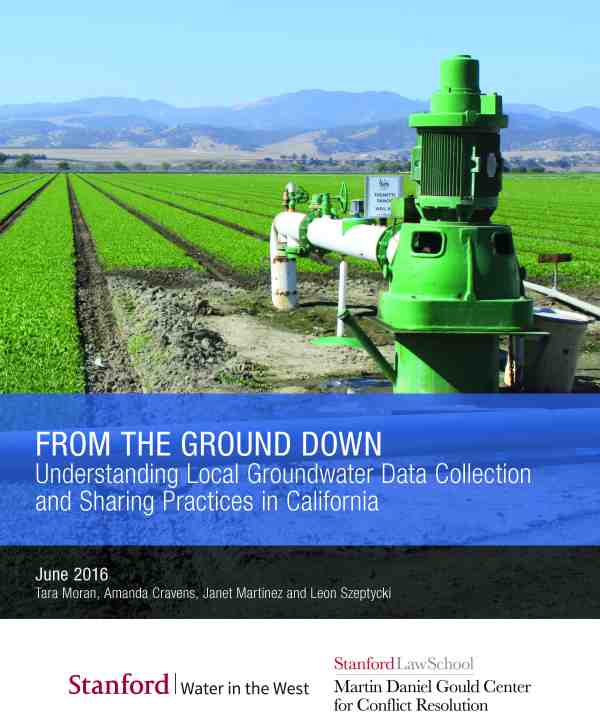June 29, 2016 | Water in the West | News
Survey of groundwater managers highlights need for standardized data monitoring, and makes policy recommendations for successful implementation of the Sustainable Groundwater Management Act of 2014 (SGMA)
After decades of dysfunction that have exacerbated chronic water problems, California is on the cusp of a new era due to historic groundwater legislation. However, meeting the law’s goals will require overcoming stubborn systemic obstacles, according to a report by researchers at Stanford’s Water in the West program and the Gould Center for Conflict Resolution at the Stanford Law School.
The statewide survey of groundwater professionals finds a range of shortcomings in groundwater data collection and use. The report also outlines regulatory and policy actions that could improve data collection and coordination, vastly improving how California handles the source of up to 60 percent of its water supply.
“Like a bank account, managing groundwater effectively requires understanding what comes into the system and what goes out,” said lead author Tara Moran, sustainable groundwater program lead at Water in the West, a joint program of the Bill Lane Center for the American West and the Stanford Woods Institute for the Environment. “That’s been impossible on a statewide level in California and even on the level of groundwater basins, which are usually managed by multiple agencies that are not required to share information.”
The Sustainable Groundwater Management Act (SGMA), passed in 2014, requires sustainable management, and takes important steps toward ensuring more effective collection and integration of groundwater data, as well as monitoring of groundwater basins, permeable areas that drain large amounts of water to natural underground storage areas. However, the law stops short of requiring local agencies to adopt statewide monitoring protocols, instead allows them some flexibility in determining the monitoring activities that best meet their needs. Yet, standardized monitoring would make groundwater information more shareable across regions and the state.
Uncoordinated and inconsistent data collection among California’s more than 2,000 local and state agencies involved in groundwater management is one of the factors that has contributed to poor groundwater management in the state. This has led to massive drops in groundwater levels, dry domestic wells, land subsidence of more than one foot per year in some locations, ecosystem die-outs and reduced stream flows.
Key findings from the survey include:
- Many local agencies do not have dedicated groundwater monitoring wells. About 12 percent of respondents with established groundwater monitoring networks did not have a single dedicated groundwater monitoring wells. Using more private wells for monitoring purposes would improve spatial coverage.
- Many data necessary for sustainable groundwater management are missing or are highly uncertain: Survey respondents indicated a high degree of uncertainty associated with groundwater recharge potential (38 percent), sustainable yield estimates (36 percent), groundwater recharge locations (28 percent) and groundwater-dependent ecosystems (26 percent)
Moran and her colleagues suggest regulatory and policy changes for local, state and federal groundwater management agencies, including:
- Use the authority under SGMA to monitor private production wells. Only slightly more than half of respondents consider the geographic coverage (54 percent) of groundwater levels data to be adequate for decision-making purposes. Using more private wells for monitoring purposes would improve spatial coverage.
- Develop a statewide advisory committee to provide guidance on new data collection technologies and other data-related topics. About 40 percent of survey respondents plan to use geophysical methods or satellite-based methods for groundwater management in the next three to five years. This committee would advise the state and groundwater management agencies on geophysical methods, technologies and other data-related topics.
- Use the authority under SGMA to implement groundwater extraction metering. Nearly 30 percent of respondents who answered an open-ended question indicated the need for groundwater extraction data.
“Achieving SGMA’s goal of sustainably managed groundwater basins will require building a shared understanding of groundwater conditions across a diverse range of interested parties,” said co-author Janet Martinez, director of the Gould Center. “This survey provides us with critical insights on the data management efforts needed to accomplish this.”
The researchers plan to release more detailed survey analysis in a series of reports and academic publications that combine survey results with key findings from an ongoing four-part groundwater data workshop series at Stanford. Read summary notes from the first two workshops on groundwater models and groundwater data.
Co-authors of “From the Ground Down: Understanding the Groundwater Data Collection, Adequacy and Sharing Practices of Local Groundwater Management Agencies in California” also include Amanda Cravens, collaborative technology specialist and researcher at the U.S. Geological Society; and Leon Szeptycki, executive director of Water in the West and Stanford Woods Institute professor of the practice.
Funding for the report provided by the S.D. Bechtel, Jr. Foundation.
Video:
Toward Sustainable Groundwater
For more information:
Tara Moran, Water in the West, tamoran@stanford.edu, 650-721-2421
Rob Jordan, Stanford Woods Institute for the Environment, rjordan@stanford.edu, 650-721-1881


![[Woods Logo]](/sites/default/files/logos/footer-logo-woods.png)
![[Bill Lane Center Logo]](/sites/default/files/logos/footer-logo-billlane.png)